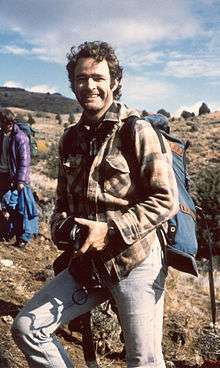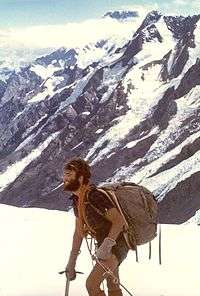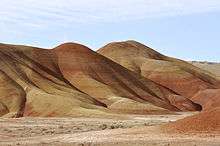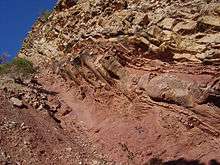Gregory Retallack
Gregory John Retallack (born 8 November 1951) is an Australian paleontologist, geologist, and author who specializes in the study of fossil soils (paleopedology). His research has examined the fossil record of soils though major events in Earth history, extending back some 4.6 billion years.[1] Among his publications he has written two standard paleopedology textbooks, said N. Jones in Nature Geoscience "Retallack has literally written the book on ancient soils."[2]
Gregory Retallack | |
|---|---|
 Greg Retallack, near Suplee, central Oregon, 1982 | |
| Born | 8 November 1951 Hobart, Tasmania |
| Nationality | Australian |
| Citizenship | American and Australian |
| Alma mater | Macquarie University, University of New England (Australia) |
| Known for | Paleopedology |
| Spouse(s) | Diane Retallack, Director Eugene Concert Choir |
| Scientific career | |
| Thesis | A biostratigraphy for terrestrial Triassic rocks of Gondwanaland (1978) |
| Doctoral advisor | Rodney E. Gould |
| Influences | Bruce Runnegar, David Dilcher, James Lovelock |
| Website | http://pages.uoregon.edu/dogsci/doku.php?id=directory/faculty/greg/about |
Biography
Retallack moved with his family from Hobart, Tasmania at age 4. He grew up in Hurstville and then Epping, in the suburbs of Sydney. He attended The King's School, Parramatta, then studied biology and paleontology at Macquarie University. He received a BSc Hons with University Medal in 1974 from the University of New England (Australia) and a PhD in 1978 in geology from the same university. After a postdoctoral fellowship at Indiana University he joined the faculty at the University of Oregon in 1981. He has been a professor in the Department of Geological Sciences since 1992, and Director of the Condon Collection of the University of Oregon Museum of Natural and Cultural History since 2009.

Work
Evolution of life on land
In 1973,[3] Retallack discovered that paleosols were preserved among fossil roots below some kinds of fossil plant horizons and that paleosols could reveal aspects of plant communities difficult to infer from the fossil plants themselves.[4] This novel approach to reconstructing life on land could be applied to understanding major events in evolution, sometimes supplementing and sometimes challenging prior understanding. Initial work was on Triassic vegetation and climate.[5] Later construction of Cenozoic paleoclimate time series led to the idea that grassland-grazer coevolution was responsible for climatic cooling over the past 50 million years,[6] which has implications for biosequestration of carbon. Fieldwork in Kenya on paleosols associated with apes (Proconsulidae) ancestral to humans revealed that the evolutionary transition to upright stance occurred in woodlands rather than savannas.[7] Paleosols of the Cretaceous-Paleogene boundary in Montana implicated abrupt paleoclimatic change and acid rain from extraterrestrial impact in the extinction of dinosaurs[8] Work on the Permian-Triassic boundary in Antarctica lead to formulation of an hypothesis of greenhouse crisis due to methane outburst associated with flood basalt in this greatest of all mass extinctions[9] Devonian fossil soils at sites for tetrapods suggest a woodland hypothesis for the evolutionary transition from fish to amphibian.[10]
Retallack discovered fossil soils at classical South Australian sites for the Ediacara biota and reported it is evidence that these fossils formerly regarded as marine were instead terrestrial organisms such as lichens, slime molds and microbial colonies.[11] Retallack has also reinterpreted volcanic tuffs of Newfoundland as terrestrial lapilli and sanidine tuffs, and so found fossiliferous Ediacaran paleosols there as well [12] A Paleoproterozoic paleosol with problematic fossils (Diskagma) comparable to the living Geosiphon (a fungus) could suggest a long evolutionary history for life on land.[13] Such putative ancient and complex life on land could support the view that life originated in soil.[14] In 2013, Retallack reported in the journal Precambrian Research that land-based microfossils found in South Africa could be as old as 2.2 billion years, pushing back the arrival of life on land much further breaking the previous record of 1.2 billion years.[15][16]

Retallack's work on Late Permian mass extinction[9] was featured on several television documentaries, including the BBC's The Day The Earth Nearly Died[18] and Science Channel USA's Miracle Planet episode "Death and Rebirth".[19] His work on Miocene of Panama[20] was featured in National Geographic Channel USA's "Terror Raptor" episode of Prehistoric Predators.[21] Radio interviews concerning his recent work on early life on land[11][13] were broadcast by Richard Harris for National Public Radio,[22] Bob McDonald for Canadian Broadcast Corporation[23] and Dave Miller for Oregon Public Broadcasting.[24]
In a challenge to young earth creationism, Retallack debunked interpretation of the fossil forests of Yellowstone National Park as deposits of volcanic lahars in which tree trunks landed upright,[25] by showing that the fossil stumps were rooted in moderately developed paleosols.[26] Because moderate development of soils can take as long as 5000 years, only a few paleosols in succession are needed to exceed the young earth creationism age of the Earth, and at Yellowstone there are at least 24 successive fossil forests.[27] Sequences of paleosols is just one of many lines of physical evidence that young earth creationism does not explain as well as conventional geology.
Paleobotany
In addition to paleopedology, Retallack continues research in paleobotany. His special interests include Triassic fossil plants such as Pleuromeia,[28] Isoetes,[29] Dicroidium[30] and Lepidopteris.[31] With David Dilcher he developed a coastal hypothesis for the dispersal and rise to dominance of angiosperms.[32] Retallack also developed new techniques for using stomatal index of fossil Ginkgo leaves to obtain past atmospheric carbon dioxide.[33] This work led Retallack to propose the concept of paleoenvironmental regulation by the Proserpina Principle: plants cool the planet, whereas animals warm it.[34] Retallack's name is honored by several fossils including Cladophlebis retallackii, fossil fern foliage,[35] Sapindopsis retallackii early angiosperm leaves[36] and Hypisodus retallacki, a fossil mouse deer.[37]

Archeology
In a study of soils at 84 temples of Classical Greece, Retallack discovered that each deity and cult was associated with a particular kind of soil, suggesting an economic basis for Greek polytheism.[38] Dionysos and Demeter, for example, were gods of farming, Hermes and Hera gods of pastoralists and Apollo and Artemis gods of nomadic hunter-gatherers
Boards
Retallack has served as an associate or technical editor for such scientific journals as Geology, PALAIOS, and Journal of Sedimentary Research. His fellowships include the Geological Society of America, and the American Association for the Advancement of Science.
He served as the president and vice president of the Cordilleran Section of the Paleontological Society, of the Oregon Academy of Sciences,[39] and of the University of Oregon Chapter of the Society of Sigma Xi.
Critical reception
Early reviews of Retallack's textbooks have been positive. Of Soils of the Past, David Fastovsky[40] concludes "it is requisite for all persons trying to understand paleosols". Of A Colour Guide to Paleosols, Daniel Yaalon[41] concludes "Highly recommended for students and researchers alike for an introductory insight to paleopedology and to whet and refine their skills in paleosol interpretation." Both reviews however baulked at the unfamiliarity of soil science terminology and classification in these texts.
Retallack's approach to the description and interpretation of paleosols has been widely adopted.[42] Some controversy concerned use of modern soil taxonomies for paleosols,[43] but Retallack's approach has since been validated by development of additional geochemical proxies for soil taxonomic criteria.[44] Retallack's confirmation of abrupt paleoenvironmental change on land at the Cretaceous-Tertiary[8] and Permian-Triassic boundaries,[9] have been supported by later research on extinction.
Retallack's initial taphonomy work interpreting some Ediacaran biota as lichens[45] was questioned[46] for its applicability to all Ediacaran fossils. The recent Retallack proposal that Ediacaran fossils were preserved in paleosols and thus could not be marine fossils,[11] is a provocative challenge to prior interpretations,[2] and has been supported in some quarters,[47] but disputed in others.[48] However this hypothesis of Retallack is not universally accepted by the paleontological community.[49][50] Nature called it a "controversial claim" in a news report, in which paleontologist Guy Narbonne said "Most of us appreciated that Retallack's lichen hypothesis was innovative thinking and tested his ideas critically, but it quickly became clear that there are simpler explanations for the features Retallack had validly noted, and most of us moved on to more promising explanations."[51]
Awards and honors
Retallack has been honored for his research, including the Stillwell Award of the Geological Society of Australia, for best paper in the society journal in 1977, and the Antarctica Service Medal of the U.S. National Science Foundation in 1999. He has been an invited lecturer throughout the U.S., and also to Germany, England, China, Thailand and India.
Bibliography
Textbooks
- Soils of the past: an introduction to paleopedology, 2nd edition, Blackwell, Oxford, 2001, ISBN 0-632-05376-3
- A colour guide to paleosols, John Wiley and Sons, Chichester, 1997, ISBN 0-471-96711-4
Selected publications
- Retallack, G. J.; Feakes, C. R. (1987). "Trace fossil evidence for Late Ordovician animals on land". Science. 235 (4784): 61–63. Bibcode:1987Sci...235...61R. doi:10.1126/science.235.4784.61. PMID 17769314.
- Retallack, G. J.; Dugas, D. P.; Bestland, A. E. (1990). "Fossil soils and grasses of the earliest East African grasslands". Science. 247 (4948): 1325–1328. doi:10.1126/science.247.4948.1325. PMID 17843796.
- Retallack, G. J.; Germán-Heins, J. (1994). "Evidence from paleosols for the geological antiquity of rain forest". Science. 265 (5171): 499–502. doi:10.1126/science.265.5171.499. PMID 17781308.
- Retallack, G. J. (1995). "Permian-Triassic life crisis on land". Science. 267 (5194): 77–80. Bibcode:1995Sci...267...77R. doi:10.1126/science.267.5194.77. PMID 17840061.
- Retallack, G. J. (1997). "Early forest soils and their role in Devonian global change". Science. 276 (5312): 583–585. doi:10.1126/science.276.5312.583. PMID 9110975.
- Retallack, G. J. (2001). "A 300 million year record of atmospheric carbon dioxide from fossil plant cuticles". Nature. 411 (6835): 287–290. Bibcode:2001Natur.411..287R. doi:10.1038/35077041. PMID 11357126.
- Retallack, G. J. (2008). "Rocks, views, soils and plants at the temples of ancient Greece". Antiquity. 82 (317): 640–657. doi:10.1017/s0003598x00097283.
- Retallack, G. J. (2013). "Ediacaran life on land". Nature. 493 (7430): 89–92. Bibcode:2013Natur.493...89R. doi:10.1038/nature11777. PMID 23235827.
References
- Retallack, G. J. (2001). Soils of the past: an introduction to paleopedology. Oxford, UK: Blackwell. ISBN 978-0-632-05376-6.
- Jones, N. (February 2013). "Soil or sea for ancient fossils". Nature Geoscience. 6 (2): 84. Bibcode:2013NatGe...6...84J. doi:10.1038/ngeo1713.
- Retallack, G. J. (1973). "Stratigraphy, palaeobotany and environmental analysis of an area around Pittwater, north of Sydney, N.S.W.". BSC Honours Thesis, University of New England. Armidale, New South Wales.
- Retallack, G. J. (1977). "Triassic palaeosols in the upper Narrabeen Group of New South Wales. Part II: Classification and reconstruction". Journal of the Geological Society of Australia. 24 (1–2): 19–35. doi:10.1080/00167617708728964.
- Retallack, G. J. (1997). "Palaeosols in the upper Narrabeen Group of New South Wales as evidence of Early Triassic palaeoenvironments without exact modern analogues". Australian Journal of Earth Sciences. 44 (2): 185–201. Bibcode:1997AuJES..44..185R. doi:10.1080/08120099708728303.
- Retallack, G. J. (2013). "Global cooling by grasslands in the geological past and near future". Annual Review of Earth and Planetary Sciences. 41: 5.1–18. doi:10.1146/annurev-earth-050212-124001.
- Retallack, G. J. (2007). "Paleosols". In Henke, W.; Tattersall, I. (eds.). Handbook of paleoanthropology, Volume 1. Principles, methods and approaches. 1. Berlin: Springer Verlag. pp. 383–408.
- Retallack, G. J. (2004). "End-Cretaceous acid rain as a selective extinction mechanism between birds and dinosaurs". In Currie, P. J.; Koppelhus, E. B.; Shugar, M. A.; Wright, J. L. (eds.). Feathered dragons: studies on the transition from dinosaurs to birds. pp. 35–64.
- Retallack, G. J.; Jahren, A. H. (2008). "Methane release from igneous intrusion of coal during Late Permian extinction events". Journal of Geology. 116 (1): 1–20. Bibcode:2008JG....116....1R. doi:10.1086/524120.
- Retallack, G. J. (2011). "Woodland hypothesis for Devonian evolution of tetrapods". Journal of Geology. 119 (3): 235–358. Bibcode:2011JG....119..235R. doi:10.1086/659144.
- Retallack, G. J. (2013). "Ediacaran life on land". Nature. 493 (7430): 89–92. Bibcode:2013Natur.493...89R. doi:10.1038/nature11777. PMID 23235827.
- Retallack, G.J. (2014). "Volcanosedimentary paleoenvironments of Ediacaran fossils in Newfoundland". Geological Society of America Bulletin. 126 (5–6): 619–638. Bibcode:2014GSAB..126..619R. doi:10.1130/B30892.1.
- Retallack, G. J.; Krull, E. S.; Thackray, G. D.; Parkinson, D. (2013). "Problematic urn-shaped fossils from a Paleoproterozoic (2.2 Ga) paleosol in South Africa". Precambrian Research. 235: 71–87. Bibcode:2013PreR..235...71R. doi:10.1016/j.precamres.2013.05.015.
- Retallack, G. J. (2007). "Coevolution of life and earth". In Stevenson, D. (ed.). Treatise of geophysics: Earth evolution. Amsterdam: Elsevier. pp. 295–320.
- Peter Byrne (24 April 2014). "Early Life in Death Valley". Quanta Magazine. Retrieved 8 May 2014. Reprinted in ScientificAmerican.com
- Gregory Retallack (September 2013). "Problematic urn-shaped fossils from a Paleoproterozoic (2.2 Ga) paleosol in South Africa". Precambrian Research. 235: 71–87. Bibcode:2013PreR..235...71R. doi:10.1016/j.precamres.2013.05.015.
- Retallack, G. J.; Bestland, E. A.; Fremd, T. J. (2000). Eocene and Oligocene paleosols and environmental change in central Oregon. Boulder, Colorado: Geological Society of America Special Paper 344. ISBN 978-0-8137-2344-0.
- "The day the Earth nearly died". Youtube. Retrieved 21 August 2013.
- "Death and rebirth". Youtube. Retrieved 21 August 2013.
- Retallack, G. J.; Kirby, M. X. (2007). "Middle Miocene global change and paleogeography of Panama". PALAIOS. 22 (6): 667–679. doi:10.2110/palo.2006.p06-130r.
- "Terror raptor". Youtube. Retrieved 21 August 2013.
- "Land creatures may not have come from the sea". National Public Radio. Retrieved 21 August 2013.
- "Fossils could preserv oldest land life". Canadian Broadcast Corporation. Retrieved 21 August 2013.
- "Evidence of the oldest life on land". Oregon Public Broadcasting. Retrieved 21 August 2013.
- Fritz, W. G. (1980). "Reinterpretation of the depositional environment of the Yellowstone "fossil forest"". Geology. 8 (7): 309–313. doi:10.1130/0091-7613(1980)8<309:ROTDEO>2.0.CO;2.
- Retallack, G. J. (1981). "Comment on "Reinterpretation of the depositional environment of the Yellowstone fossil forest"". Geology. 9 (2): 52–53. doi:10.1130/0091-7613(1981)9<52:CARORO>2.0.CO;2.
- Dorf, E. (1964). "The petrified forests of Yellowstone National Park". Scientific American. 210 (4): 107–113. doi:10.1038/scientificamerican0464-106.
- Retallack, G. J. (1975). "The life and times of a Triassic lycopod". Alcheringa. 1: 3–29. doi:10.1080/03115517508619477.
- Retallack, G. J. (1997). "Earliest Triassic origin of Isoetes and quillwort evolutionary radiation". Journal of Paleontology. 71 (3): 500–521. doi:10.1017/S0022336000039524. JSTOR 1306630.
- Retallack, G. J.; Dilcher, D. L. (1988). "Reconstructions of selected seed ferns". Annals of the Missouri Botanical Garden. 75 (3): 1010–1057. doi:10.2307/2399379. JSTOR 2399379.
- Retallack, G. J. (2002). "Lepidopteris callipteroides, the earliest Triassic seed fern in the Sydney Basin, southeastern Australia". Alcheringa. 26 (4): 475–499. doi:10.1080/03115510208619538.
- Retallack, G. J.; Dilcher, D.L (1986). "Angiosperm invasion of North America". Cretaceous Research. 7 (3): 227–252. doi:10.1016/0195-6671(86)90027-3.
- Retallack, G. J. (2001). "A 300 million year record of atmospheric carbon dioxide from fossil plant cuticles". Nature. 411 (6835): 287–290. Bibcode:2001Natur.411..287R. doi:10.1038/35077041. PMID 11357126.
- Retallack, G. J. (2007). "Soils and global change in the carbon cycle over geological time". In Holland, H. D.; Turekian, K. K. (eds.). Treatise of geochemistry. Oxford: Pergamon Press. pp. 581–605.
- Holmes, W. B. K. (2003). "The middle Triassic megafossil flora of the Basin Creek Formation, Nymboida Coal Measures, New South Wales. Part 3. Fern-like foliage". Proceedings of the Linnean Society of New South Wales. 124: 53–108.
- Wang, H.-S.; Dilcher, D.L. (2018). "Early Cretaceous angiosperm leaves from the Dakota Formation, Hoisington III locality, Kasas, USA". Palaeontologia Electronica. 21.3.34A: 1–49.
- Meehan, T. J.; Martin, L. D. (2004). "Emended genus description and a new species of Hypisodus (Artiodactyla: Ruminantia; Hypertragulidae)". In Lucas, S. G.; Zeigler, K. E.; Kondrashov, P. E. (eds.). Paleogene mammals. Albuquerque: New Mexico Museum of Natural History and Science Bulletin. pp. 237–143.
- Retallack, G. J. (2008). "Rocks, views, soils and plants at the temples of ancient Greece". Antiquity. 82 (317): 640–657. doi:10.1017/s0003598x00097283.
- "The Oregon Academy of Science". Oregon Academy of Science. Archived from the original on 7 August 2013. Retrieved 21 August 2013.
- Fastovsky, D. E. (1991). "Book Reviews". Sedimentology. 38: 181–184. doi:10.1111/j.1365-3091.1991.tb01867.x.
- Yaalon, D. H. (1998). "Book Review". Sedimentary Geology. 116 (3–4): 275–280. Bibcode:1998SedG..116..276Y. doi:10.1016/S0037-0738(97)00105-X.
- Driese, S. G.; Nordt, L. C. (2012). New frontiers in paleopedology and terrestrial paleoclimatology. Tulsa, Oklahoma: Society for Sedimentary Geology. ISBN 978-1-56576-322-7.
- Nettleton, W. D.; Olson, C. G.; Wysocki, D. A. (1998). "Paleosol classification: problems and solution". Catena. 41 (1–3): 61–92. doi:10.1016/S0341-8162(00)00109-0.
- Nordt, L.; Driese, S. G. (2010). "A modern soil characterization approach to reconstructing physical and chemical properties of paleo-Vertisols". American Journal of Science. 310: 37–62. doi:10.2475/01.2010.02.
- Retallack, G. J. (1994). "Were Ediacaran fossils lichens?". Paleobiology. 20 (4): 523–544. doi:10.1017/S0094837300012975.
- Waggoner, B. (1995). "Comment on "Were Ediacaran fossils lichens?"". Paleobiology. 21: 397–398.
- Knauth, L. P. (2013). "Not all at sea". Nature. 493 (7430): 28–9. doi:10.1038/nature11765. PMID 23235825.
- Xiao, S. H. (2013). "Muddying the waters". Nature. 493 (7430): 28–29. doi:10.1038/nature11765. PMID 23235825.
- Waggoner, B. M. (1995). "Ediacaran Lichens: A Critique". Paleobiology. 21 (3): 393–397. doi:10.1017/S0094837300013373. ISSN 0094-8373. JSTOR 2401174.
- Waggoner, B.; Collins, A. G. (2004). "Reductio Ad Absurdum: Testing The Evolutionary Relationships Of Ediacaran And Paleozoic Problematic Fossils Using Molecular Divergence Dates". Journal of Paleontology. 78 (1): 51–61. doi:10.1666/0022-3360(2004)078<0051:RAATTE>2.0.CO;2. ISSN 0022-3360.
- Switek, Brian (12 December 2012). "Controversial claim puts life on land 65 million years early". Nature. doi:10.1038/nature.2012.12017. Retrieved 19 November 2013.
External links
- Gregory Retallack on IMDb
- Personal web page
- Gregory Retallack publications indexed by Google Scholar